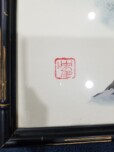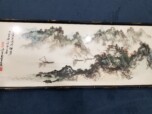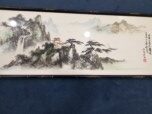I first visited China in November 1984, spending one week in Beijing and another in Tianjin, where my department had an academic exchange program. It was cold and it even snowed in Beijing; because it was slightly before the date the government allowed furnaces to be turned on north of the Yangtze River, the worst of the cold was indoors. Everyone wore a blue Mao jacket and cap and rode a bicycle. The official guidebook for the Forbidden City included a long doctrinal discussion about why this seat of imperialist oppression was not destroyed as a revolutionary act, and the answer given was that it displays the brilliant artistic achievements of Chinese workers.
One day in Beijing I bought two paintings from an artist selling them on the street and remember paying him $20 for the pair. On my return, I had them unrolled, mounted, and framed. Their dimensions are substantial – 46 inches wide and 17 inches high.
One in a Million Times 1300
I recently engaged an expert in Asian art to research their provenance. The paintings were done in winter 1984, and the artist used a partial seal with the given name “An Ji.” This brings to mind Thomas Friedman’s observation that in China if you are one in a million, there are 1300 people just like you. An Ji is an excellent landscape artist, but not so exceptional that he is known by his first name alone. He is, unfortunately, an anonymous Chinese artist. The expert told me the value of the paintings had appreciated into four figures, but it would have been more had we known the artist’s surname. Here, at least, is his partial seal.
Green River Water
Inscribed on both paintings is a poem by the Tang dynasty public servant and poet Bai Juyi (772-846) entitled Recalling Jiangnan.
“The excellent scenery of Jiangnan
Known well like an old friend,
Sun comes up, the blossoms seem like a flaming fire
Spring arrives, the river water is green like grass,
Who cannot remember Jiangnan?”
Jiangnan refers to the land south of the Yangtze River and includes Shanghai and the famously beautiful cities of Suzhou and Hangzhou. Jiangnan has the connotation of a land of scenic beauty, indeed a utopia.
An Ji’s two paintings are thus idealized scenes along the Yangtze or other rivers of southern China. They include steep craggy mountains, stone paths leading up to temples, waterfalls, forests on the mountain slopes, and sailboats on the river. There are mountains in the foreground, rivers in the middle, and other ranges of mountains in the distance. The brushwork is in blacks, greys, and light blue. I appreciate that in both paintings An Ji has left much of the canvas unpainted. In this style of traditional landscape painting, much can be suggested rather than precisely depicted.
I often compare the two paintings, which have the same components (mountains, temples, rocky paths, sailboats on the river) but arrange them in different ways. I will often ask which features I prefer in one painting and which one, overall, I like better. It is a compliment to An Ji that my answers change from day to day.
One of the most popular tours in China is the Li River cruise near the city of Guilin. This region is famous for its limestone formations known as karsts. (Indeed, I did this cruise with my mother on a trip to China in 1986.) An Ji is painting a scene that has some of the characteristics of the Li River, but isn’t the Li River. That is another reason why I refer to it as idealized.
In the Exercise Room
I have an exercise room in the basement, a vestibule between a finished bedroom and the unfinished furnace room. The exercise room has the wide walls that are necessary for showing these two paintings. When exercising, I try to achieve a state of relaxation and attentiveness to my body. I will gaze at these paintings because they help me achieve the bodily calmness that contributes to an effective workout.
Nearing the Finish Line
This is my last post about a specific work of art. When I started in July, I planned to finish posting about my art collection by Labour Day. Before I go on to other topics, early next week I will discuss what I’ve learned from the process of researching and writing these posts.




Leave a Reply